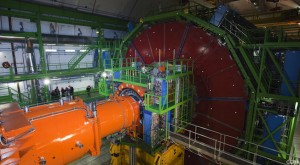Einstein’s theory of relativity is standing stronger than ever in the wake of the results of a new experiment out of the European Organization for Nuclear Research (CERN), which found that particles that scientists initially thought were traveling faster than the speed of light were actually moving more slowly.
Back in September 2011, CERN scientists shocked the world by announcing that one of the agency’s particle physics experiments, called OPERA, had detected neutrinos, a type of uncharged particle, traveling 60 billionths of a second faster than the speed of light through a 454-mile expanse of earth connecting an underground lab near Geneva, Switzerland to one near Assergi, Italy.
Those results came in violation of Einstein’s theory of relativity, which states that nothing in the universe can move faster than the speed of light in a vacuum.
But after re-measuring the speed of the neutrinos in a different experiment called ICARUS, CERN on Friday announced that the neutrinos were actually moving equal to the speed of light and the original paradigm-shattering results were most likely due to a measuring error.
“ICARUS measures the neutrino’s velocity to be no faster than the speed of light,” said Carlo Rubbia, spokesperson of the ICARUS experiment and a Nobel prize winner, in a statement published on CERN’s website.
“The evidence is beginning to point towards the OPERA result being an artifact of the measurement,” said CERN Research Director Sergio Bertolucci in CERN’s statement.
CERN published the new results of the ICARUS experiment in a paper, noting that the original results would have called for “a complete reconsideration of the basic principles of particle physics.”
The latest results would seem to further vindicate the reflexive wave of skepticism from the scientific community about CERN’s original faster-than-light results.
In the weeks following CERN’s original announcement, scientists and science writers quickly proposed alternative theories suggesting that discrepancies in CERN’s measuring system could have erroneously produced the faster-than-light results, such as a widely circulated theory that CERN didn’t take into account the fact that the GPS satellites they were using to keep track of the particles had slightly different timing than CERN’s clocks on the ground.
However, Bertolucci on Friday cautioned that the scientists at the Gran Sasso facility in Italy where the OPERA and ICARUS experiments are run, still need to conduct additional experiments and re-measure the neutrinos speed before a “final verdict” is reached. The decisive experiments are planned to occur in May 2012, according to CERN.
“These are difficult and sensitive measurements to make and they underline the importance of the scientific process,” Rubbia added.
Bertolucci aslo attempted to defend the OPERA experiment’s record of reliability.
“Whatever the result, the OPERA experiment has behaved with perfect scientific integrity in opening their measurement to broad scrutiny, and inviting independent measurements,” Bertolucci said. “This is how science works.”
Or doesn’t work, as the case may be. Although the OPERA experiment re-tested its unfathomable faster-than-light particle results in November 2011 and found the same result, the entire experiment could have been flawed due to mechanical errors.
In late February 2012, Science Insider broke the news that CERN had discovered a loose cable connecting OPERA’s GPS timing instrument to a computer that could have erroneously caused the detection of the faster-than-light results. CERN later confirmed that it had indeed found a loose cable in the experiment but that it also uncovered a second glitch in an oscillator, another instrument, which could have actually caused the experiment to underreport the speed of the particles, potentially meaning they were flying even faster than initially reported.
But the latest results out of CERN’s Icarus don’t bode well for the possibility of faster-than-light travel. So until May, when CERN comes out with the definitive results, Einstein’s theory remains the bedrock of modern physics.
Correction: This article originally misstated that the OPERA experiment sent neutrinos through an underground tunnel between the laboratory near Geneva to the laboratory near Assergi. In fact, though the equipment is located in underground tunnels, the particles themselves traveled through rock. There is no such tunnel connecting the two labs. This article also originally mistakenly described neutrinos as weakly charged, when in fact they are uncharged. We have since corrected the errors in copy and regret them.

